
| |
| HOME |
| About Tenaya |
| About Us |
| Latest Update |
| Logs from Current Year |
| Logs from Previous Years |
| Katie's View |
| Route Map |
| Links |
| Contact Us |
| Sailing to Antwerp |
|
|
We enjoyed the 3 years we lived in Antwerp so returning by boat was in our plans. We needed to fill our food lockers and one of our favorite places to shop is the Asian market area. Katie also wanted some colorful pillows and knew which shops to visit.
The Cruising Companion for North France and Belgium by Neville Featherstone made the trip sound exciting: "TRAFFIC DENSITY is high! There are many big ships, all making best speed for commercial reasons and having absolute priority. Barges are hard to see because they are low in the water." The tidal range is 5.6 meters (That's more than 18 feet) and the tidal current averages 3 knots.
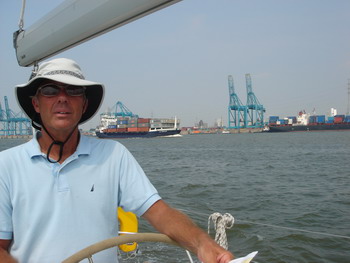
There really are "many big ships". The Port of Antwerp handled 15,283 large ships in 2005 and loaded and unloaded 6 1/2 million containers making it larger than any port in the USA. Hong Kong and Singapore are larger, but the approach to Antwerp is what makes it so exciting for a small sailboat. The approach to the port is 48 miles along the Schelde River. We sailed from Holland and followed the Zuid Beveland canal to Hansweert on the Schelde which left about 25 miles of the river to Antwerp. Many parts of the channel are not much wider than 100 meters and it is not uncommon to have 2 container ships passing each other at the same narrow point while you work hard to keep out of their way.
Every "How to Cruise" book warns about relying only on GPS and a chart plotter. We have the most up to date electronic charts available (Navionics Platinum 2006) but they did not show a new container ship port that required that we cross the channel to the other side and many of the sand banks were in different positions on the Dutch charts. We followed the Dutch Yacht charts and had no problems, but it is hard to watch the chart plotter as our ship's position would cross sand banks half the depth of Tenaya's keel.
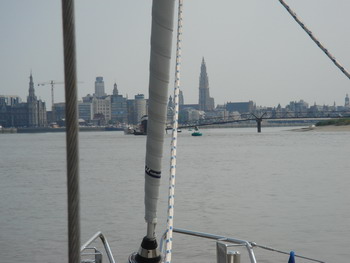
After we reached Antwerp we had to wait for space in Royerssluis lock. Commercial traffic has the priority.
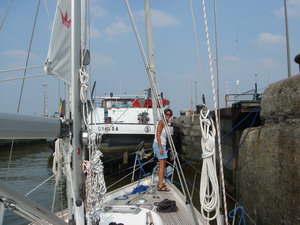

Statue of Brabo throwing Antigon's hand into the river
Read more about the city of ANTWERP
A walking tour of Antwerp is the best way to see the city. Stop by the City Tourist Office on the Grote Markt for maps and suggested walks.
|
||
|
||
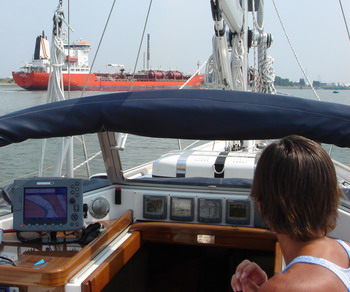
Each time a ship passed us it seemed huge and very close. But then the next one would be even larger and closer. By the time we had passed the many locks that open into the harbor of Antwerp we were getting used to them.
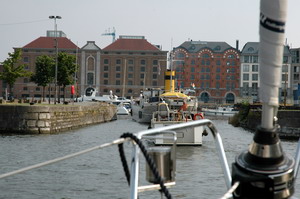
Entering Willemdok. It's a pleasant, modern marina located very near the city center. Everything is within walking distance.
This is the oldest part of the Antwerp port. The attached dock is named Bonaparte, which Napoleon ordered built. Near the marina is a building that still has a cannonball in the gable, a reminder of the bombardment of the docks in 1814 when Napoleon's warships were moored here.
Every place, whether a marina or a city or a country has it's positive points and it's negative ones. Willemdok has a couple of negatives - first just getting there through the Royerssluis lock is a bit of a problem, especially if there are a lot of barges waiting. We waited 2 hours to be allowed in (with no other recreational yachts) and might have waited longer had we not called back as the last barge was entering instead of waiting for their return call. Second, currently the Willemdok area is undergoing a major upgrade and construction of new underground parking at the marina started at 7:00 in the morning.
On the positive side, you are very close to the city center. Actually right next to the Red Light District which is smaller but similar and much less touristy than Amsterdam. The official Antwerp City guide says,"a true melting pot and heaven on earth for every sailor in Antwerp".
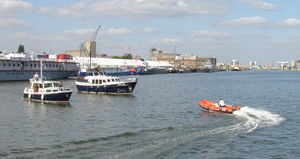
The harbormasters, Tony and Raymond, are very friendly and helpful. When the last bridge opens allowing you to enter Willemdok one of them is there in a red RIB to greet you and lead you to an open location. Tony lived in the U. S. for a while and we had a fun talking about some of our cultural differences.
Read more about Antwerp Marina

Castle Steen
This is one of the oldest fortresses in Europe. Not much is known about its early years except that the city was a trading village as far back as 700 a.d., Norse seamen sacked the place after 800 a.d., and the castle was built some time after 900 a.d. as part of the western fortifications of the Holy Roman Empire. The painter Pieter Paul Rubens lived in the castle during his declining years, and it is currently home to the National Scheepvaartmuseum (Belgian National Maritime Museum). The Steen was rebuilt in the 16th century, and you can tell the new stonework from the old stonework by the color. Outside is a cross where condemned convicts would pray before being executed during the centuries when the Steen was used as a prison.
The castle actually appears on the city's coat of arms, flanked by a pair of severed hands. This comes from the legend of the Roman soldier Silvius Brabo. He is said to have challenged Druon Antigon, the giant who charged people a toll to cross the Scheldt River not far from the castle Steen. Those who could not pay had their hands cut off and thrown into the river. According to the legend, Silvius Brabo cut off the giant's hands and threw them into the river, thus freeing the bridgehead. You can decide for yourself if this is true, however it is interesting to note that the city's Flemish name "Antwerpen" means "to throw a hand." The Steen was first built in the 12th century. In 1520, Emperor Charles V had it renovated. Over 500 years it has served many uses, including being a prison and today it houses the National Maritime Museum. It's about a 10 minute walk from the marina.
Antwerp, along with Cologne, were the economic giants of Northern Europe in the 1500s. Antwerp was considered the art capital of Europe and was one of the most important book printing centers. In 1526 alone more than 2000 different books were printed in Antwerp, including maps by Mercator. A visit to the Plantin-Moretus museum, with hundreds of original books and maps is a must.

Cathedral of Our Lady. It took nearly 170 years to build (1352-1521). The steeple is 123 meters (400 feet) high.

We were in Antwerp for the 50th Anniversary of the Tall Ships Race. It is organized by Sail Training International, a charity dedicated to the development and education of young people of all nationalities, cultures, religions and social backgrounds through the sail training experience.
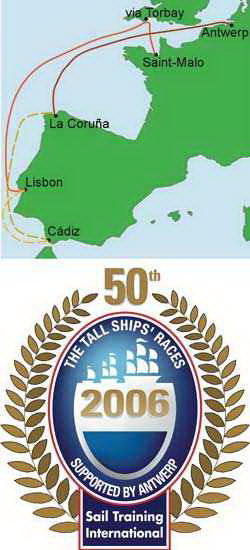
Read more about the Tall Ships Race